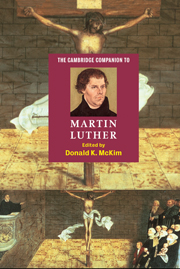Book contents
- Frontmatter
- Part I Luther’s life and context
- Part II Luther’s work
- 3 Luther’s writings
- 4 Luther as Bible translator
- 5 Luther as an interpreter of Holy Scripture
- 6 Luther’s theology
- 7 Luther’s moral theology
- 8 Luther as preacher of the Word of God
- 9 Luther’s spiritual journey
- 10 Luther’s struggle with social-ethical issues
- 11 Luther’s political encounters
- 12 Luther’s polemical controversies
- Part III After Luther
- Part IV Luther today
- Select bibliography
- Index
11 - Luther’s political encounters
from Part II - Luther’s work
Published online by Cambridge University Press: 28 May 2006
- Frontmatter
- Part I Luther’s life and context
- Part II Luther’s work
- 3 Luther’s writings
- 4 Luther as Bible translator
- 5 Luther as an interpreter of Holy Scripture
- 6 Luther’s theology
- 7 Luther’s moral theology
- 8 Luther as preacher of the Word of God
- 9 Luther’s spiritual journey
- 10 Luther’s struggle with social-ethical issues
- 11 Luther’s political encounters
- 12 Luther’s polemical controversies
- Part III After Luther
- Part IV Luther today
- Select bibliography
- Index
Summary
In 1517, Martin Luther did not intend to start a revolution, but start one he most certainly did. By the time of his death, the religious, social, and political map of Europe was unalterably changed. Luther erupted on to the scene at a decisive moment. The Holy Roman Empire in the early sixteenth century was a society in flux; old orders were giving way to a yet-to-be determined new order. Economically, northern Europe was recovering from the decimation of the fourteenth and fifteenth centuries. Its recovery, however, was dramatically different from what had preceded it. It was now more urban than rural, more based in manufacturing than agriculture. Politically, the greater nobles and the Free Imperial cities tried to stave off attempts at centralization by the emperor, while lesser nobles and rural towns tried to maintain their status as the economic world changed around them and thus marginalized them. Socially, the urbanization brought both a new middle class and at the same time a more entrenched poverty. Meanwhile, peasants had been chafing under the bit of serfdom for more than a century and a half. They were in search of justice and desperate for hope. Religiously, people both resented and depended upon the church. They resented the church because it controlled so much of the land and took too much in tax. They, however, depended on the church as the only avenue to salvation. It is little wonder, then, why Luther’s religious message struck chords on many levels. Many people heard the religious message, but could not miss its social and political import.
- Type
- Chapter
- Information
- The Cambridge Companion to Martin Luther , pp. 179 - 191Publisher: Cambridge University PressPrint publication year: 2003
- 5
- Cited by



